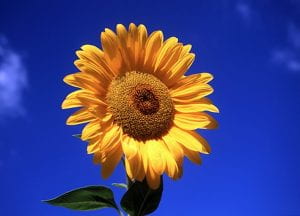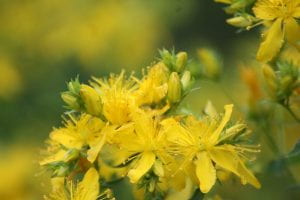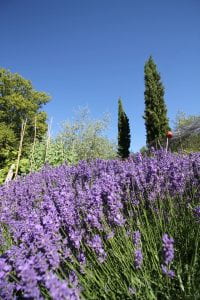By Susan Stephens
Summer is officially here! The first day of summer in the UK was on 21st June, the summer solstice, which is when the sun reaches its highest point in the sky and it is also the longest day. Summer solstice has always been linked with plants and flowers as it is a time of fertility, abundance and growth.

Sunflowers are seen as a symbol of the summer solstice. Their botanical name is Helianthus annus. Helianthis is derived from the Greek ‘Helios’ meaning sun and Anthos meaning flower, and from the Latin annuus meaning annual. Young sunflowers track the sun as it moves across the sky. They face east in the morning towards the rising sun and follow the path of the sun until they are facing west when the sun sets. By morning they are facing east again in readiness for the sunrise. This is known as heliotropism. Once they are fully grown the mature sunflower no longer follows the sun and faces east continuously. Many other flowers are heliotropic including daisies (Bellis perennis) which close their petals at night facing in random directions but open in the morning and turn to the east and follow the sun throughout the day. You can see Sunflowers growing in the Native American Veg Bed. Native Americans used to make bread and cakes from crushed, ground seed; mixed the meal with vegetables such as corn, beans and squash and ate the seeds as a snack as we still do today.

In pagan celebrations healing herbs were believed to be at their most powerful and potent when harvested on the summer solstice. It was thought that this was when evil spirits would appear and people would wear protective garlands of herbs and flowers to ward them off. One of the most powerful was ‘chase devil’ now known as St. John’s Wort (Hypericum perforatum) because of its association with St. John’ solstice feast day. It has clusters of bright yellow, shaped blooms in mid summer. The Celts believed St. John’s to be a magical plant which would bring prosperity, protection and peace and an abundant harvest. Gathering this plant on the solstice, preferably in the nude, was thought to harness the energy of the sun at its strongest. It was used in charms to protect against heartbreak and to cultivate a brave heart. Today St. John’s Wort supplements are thought to help with the symptoms of depression. St. John’s Wort can be seen growing in the Chinese Herb Garden.
Ladies Bedstraw (Galium verum) is another plant which is at its best at the time of the summer solstice. In medieval times its sweet smelling flowers were used to stuff mattresses to ward off insects and to keep pregnant women healthy. The flowers were also used to dye hair, clothes and even cheese. According to folklore the flowers transform into fairies during the night of the summer solstice. Nowadays it is an important food source for pollinators including butterflies and their caterpillars, and bees. Ladies Bedstraw is growing in the meadow amongst the grasses and other meadow flowers including Lotus corniculatus (Bird’s-foot trefoil), Centaura nigra (Knapweed), Trifolium pratense (Red clover), Daucus carota (Queen Anne’s Lace) and many more.
 Lavender (Lavandula spp) is another plant which was believed to heal and give protection in ancient times. On the summer solstice people would mix lavender with mugwort, chamomile and rose to attract elves and fairies. It would be harvested on the day of the solstice as a way of honouring midsummer. The longest stems were used to form lavender wands and the remainder would be dried in bundles and hung beneath the eaves to dry. Lavender is used today by drying the flowers to make into lavender bags or to flavour foods and drinks. Lavender is endemic to the Mediterranean region and can be found in the Western Herb Garden and on the Mediterranean Bank.
Lavender (Lavandula spp) is another plant which was believed to heal and give protection in ancient times. On the summer solstice people would mix lavender with mugwort, chamomile and rose to attract elves and fairies. It would be harvested on the day of the solstice as a way of honouring midsummer. The longest stems were used to form lavender wands and the remainder would be dried in bundles and hung beneath the eaves to dry. Lavender is used today by drying the flowers to make into lavender bags or to flavour foods and drinks. Lavender is endemic to the Mediterranean region and can be found in the Western Herb Garden and on the Mediterranean Bank.
Mugwort (Artemisia spp) is one of the oldest herbs to be used in traditional medicine. It is regarded as a Moon herb. Beliefs associated with this plant during the summer solstice are about its magical qualities which work in revealing shrouded mysteries when the night is at its shortest. Burning a few leaves in the bedroom before going to bed or placing them beneath the pillow was thought to induce prophetic dreams. In the Western Herb Garden Artemisia is planted in the beds which contain plants for treating Infection, Infestation and the Immune System; Glandular and Digestion disorders.
Mullein (Verbascum spp) is another plant of the summer solstice also called Hag Sticks because the tall sticks were dipped in animal fat and lit as candles to work within the woods or light the way. They were burned in summer solstice bonfires for protection as it was believed that Mullein had connections to the spirit. The ashes would be gathered and made into amulets or ointments for protection and healing charms throughout the year. Mullein can be seen flowering in the Ballast Seed Border.
Other summer plants harvested at the time of the summer solstice when they were believed to have attained the peak of their medicinal value were Chamomile, Calendula, Fennel, Hemp, Rosemary, Thyme, Meadowsweet, Verbena, Sage, Mint, Elder and Roses. They would be dried in order that they were available for use for the rest of the year. They were also used for oils, tinctures and teas using the parts of the plants that are above ground and capture the sunshine at its peak. We still use these herbs both fresh and dried, as flavourings for food and medicinally. All of these plants can be found growing at the Botanic Garden looking their very best at the time of the summer solstice and throughout the summer.

